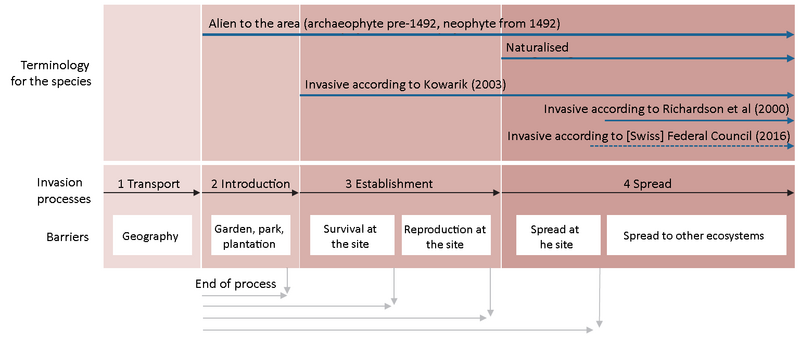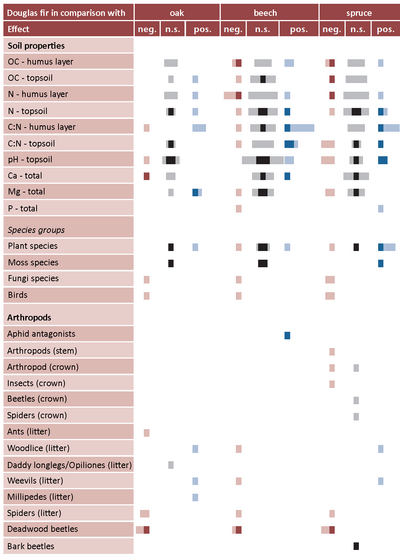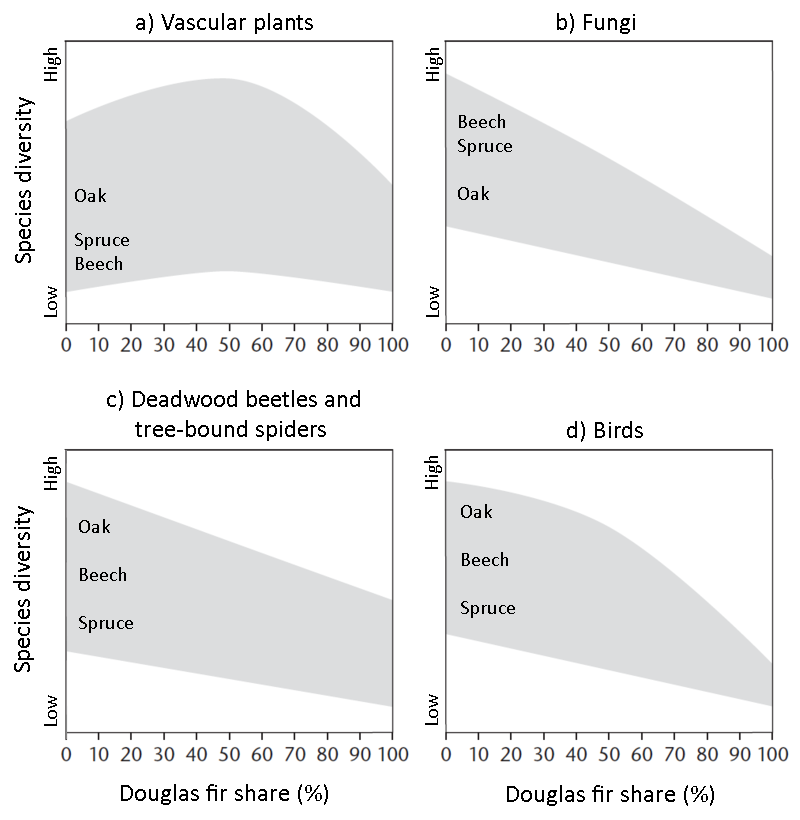To what extent should non-native tree species be used to maintain the ecosystem services provided by our forests, and timber production in particular? This question has never been as relevant as since the summer drought of 2018, when pine, spruce and beech stands all dying at the same time made it clear that hot and dry periods of weather in summer are probably among the most serious consequences of climate change. Summer droughts have already caused high tree mortality in some areas, both directly through desiccation and indirectly, by weakening the trees and reducing their resistance to subsequent infestation by beetles or fungi.
High growth, good timber properties, drought-tolerant
In its native habitat, the tall-growing Douglas fir is exposed to months of summer drought and is adapted to it, which is why the hot and dry weeks from June to September of recent years in central Europe seem to have less effect on it than on other tree species. Douglas fir achieves impressive growth rates on both productive and poor sites, and it has excellent timber properties (Fig. 1).
This is one reason why Douglas fir is favoured in France. In Germany, too, reference is often made to the high value added currently generated by the cultivation of Douglas fir. Under today's climatic conditions, Douglas fir can be used on many forest sites, although the number of sites that are climatically suitable for its cultivation at lower altitudes in central Europe will fall as temperatures continue to rise. Its optimum growth zones will then shift to altitudes above 1000 metres above sea level. In general the coastal Douglas fir (P. menziesii var. menziesii) is preferred for forestry utilisation, especially suitable provenances of this variety from the area of origin on the northern Pacific coast. The inland Douglas fir (P. menziesii var. glauca) is susceptible to Swiss needle cast (Phaeocryptopus gaeumannii) and should generally be avoided.
The Douglas fir in Europe
The genus Pseudotsuga originated in North America (Pseudotsuga menziesii and P. macrocarpa) and spread via the Bering Strait to Asia (P. japonica, P. sinensis) around 30 million years ago. Cone finds in Germany bear witness to the presence of a long-extinct species (P. jechorekiae sp. nova) in Europe some 15 to 11 million years ago. There is no more recent evidence.
The common Douglas fir was introduced to Europe from North America in 1827, and by the beginning of the 20th century, it had been planted in many forests in various countries. Cultures of the inland Douglas fir (P. menziesii var. glauca) in particular suffered some setbacks due to outbreaks of Rhabdocline needlecast (Rhabdocline pseudotsugae). Once planting had been restricted to the coastal variety (P. menziesii var. menziesii) for afforestation measures, after the two world wars in particular, the tree species became widespread.
Invasive or not?
The opportunities presented by the cultivation of Douglas fir are offset by the risks associated with its introduction as an alien tree species. The first question that arises is whether the Douglas fir is capable of spreading by itself in central European forest societies, and whether it could thus displace plant species of conservational relevance.
Where Douglas fir has already been growing in stands or groups for decades, young growth is present, but there is generally no evidence of it spreading. In Switzerland, however, conspicuous thickets have been observed on dry ground in Valais and Ticino. Although Douglas fir can sometimes have an adverse effect on the local plant species diversity over small areas in a few dry-acidic sites in southern Germany, comparable conditions are not known in Switzerland.
Where low-nutrient and dry site conditions prevail, the Douglas fir can keep pace with native tree species or even overgrow them (Fig. 2). The findings from field surveys and experiments carried out in Switzerland confirm field observations made in Germany, which is why caution is urged against the indiscriminate use of Douglas fir in silviculture. Douglas fir is thus labelled “invasive” in Germany, and “potentially invasive” in Austria. This raises the question of how we define the word “invasive”. It is certainly open to interpretation, as reflected in the different definitions that exist.
Definitions of "invasive"
Alien species are considered “invasive” when they form self-sustaining populations, spread from the place of introduction, and have an adverse effect on their environment. Although this definition is widely accepted, clarifications are necessary for decision-making processes (Fig. 3).
While Kowarik (2003) describes those species as invasive that survive after being introduced to a new location and thus find themselves in a process of invasion, for Richardson et al. (2000), only those species that become established more than 100 metres away from the original plant within 50 years qualify for this status.

Fig. 3: Processes of biological invasion and associated terms, modified from Blackburn et al. (2011) and with information from Kowarik (2003) and Swiss Federal Council (2016). For references see original article.
In Switzerland, a species is considered an “invasive alien” if it is known or must be assumed (potentially invasive) that its spread may have an adverse effect on biodiversity, ecosystem services and their sustainable use, or endanger humans and the environment. In Germany, a species is invasive if it poses a significant threat to biodiversity.
Once a species is classified as invasive, this can influence political decisions and, in the case of tree species, lead to restrictions on their cultivation. There is room for debate here, firstly on whether a species is considered to be spreading successfully, and secondly on whether its spread may be harmful to ecosystems and their services, the environment and people.
Impact on soil properties and biodiversity

Fig. 4: Effects (negative, non-significant, positive) on soil and biodiversity in studies comparing pure Douglas fir stands with pure or mixed stands of oak, beech and spruce in central Europe (for references see original article). The dark colours refer to reliable studies with several comparison pairs, light colours to case studies in which only plantations at one site were compared. Each square represents one study; in the case of non-significant properties, a study may be placed for reasons of symmetry as two half-squares to the left and right of the bar.
Extensive reviews and numerous detailed studies on individual aspects show generally more favourable soil conditions under Douglas fir than under spruce, as well as a tendency towards less favourable conditions than under oak and beech (Fig. 4). On productive sites, the nutrient discharge from Douglas fir is comparable to that from spruce, but higher than the discharge from beech.
While Douglas fir does not appear to degrade the topsoil substantially, it is likely to lead to additional nutrient depletion on poor soils. On productive sites however, which is where Douglas fir is predominantly cultivated in Switzerland, it cannot be said that Douglas fir has a strongly negative effect on the soil.
With regard to biodiversity, it became clear that for vascular plants, it is mainly the stand structure and canopy closure or the amount of light penetrating the canopy that are decisive for the number and composition of species. While there is little data available on mosses, the comparative studies on the number of species of fungi, birds and arthropods (insects, spiders, etc.) showed that pure Douglas fir stands are significantly poorer in terms of number of species and provide a habitat for fewer species than stands of oak, beech and spruce (Fig. 4). Only a few animal species groups are richer in species in Douglas fir stands than in spruce stands.
Most studies agree that the cultivation of Douglas fir has a strong negative impact on biodiversity, especially in very high proportions (Fig. 5) or in pure stands. This is reflected in lower numbers of fungi in the soil under Douglas fir, and fewer arthropods and arthropod species in the bark and crowns of Douglas firs, which effectively means that Douglas firs also provide less food, especially for wintering forest birds. In addition, Douglas fir also shows less diversity when it comes to the organisms involved in the decomposition of deadwood.
Several studies point out that the negative effects on diversity and functions are reduced in mixed stands. In addition, more and more potential pests, such as native bark beetle species or recently introduced pests, are likely to adapt to the Douglas fir.
At present, the situation in Switzerland is not as dramatic or as risky as it is in Germany and France, where the nationwide proportion of Douglas fir in forests is around ten times greater. The proportion of Douglas fir will however increase in Swiss forests in the coming decades as a consequence of plantations on the Central Plateau. In order to spread the risk, mixed stands should be favoured when it comes to the use of Douglas fir in forestry. The key question is the proportion of Douglas fir in a forest from which negative effects on biodiversity become apparent.
Proportion of Douglas fir is decisive
Based on a literature search, the following rough conclusion can be drawn here: While the extreme points in Fig. 6 of pure stands with native tree species and Douglas fir refer to the studies discussed in Wohlgemuth et al. (2021) , the assessments of the trends in species diversity between these are the result of an estimation by experts. This shows that the negative effects on biodiversity increase significantly with increasing proportions of Douglas fir in the species mixture. The effect on the various species groups is variable, however, and as yet, not enough is known about the exact course of these dependencies - there is a need for research into the effects of the degree of mixing, which is crucial for future forest management.

Fig. 6: Assessment of the impact of Douglas fir in a variable mixture with oak (Quercus sp.), beech and spruce on the diversity of different species groups, based on the literature study by Wohlgemuth et al. (2021). The grey area corresponds to a hypothetical variation range. The positions of “oak”, “beech” and “spruce” indicate the presumed mean species diversity in pure stands of these species. The large variation range for the vascular plants reflects different degrees of light penetration as a result of thinning measures.
Translation: Tessa Feller




![[Translate to English:] [Translate to English:]](/assets/_processed_/6/c/csm_fva_douglasienholz_2_e31f8d540d.jpeg)
